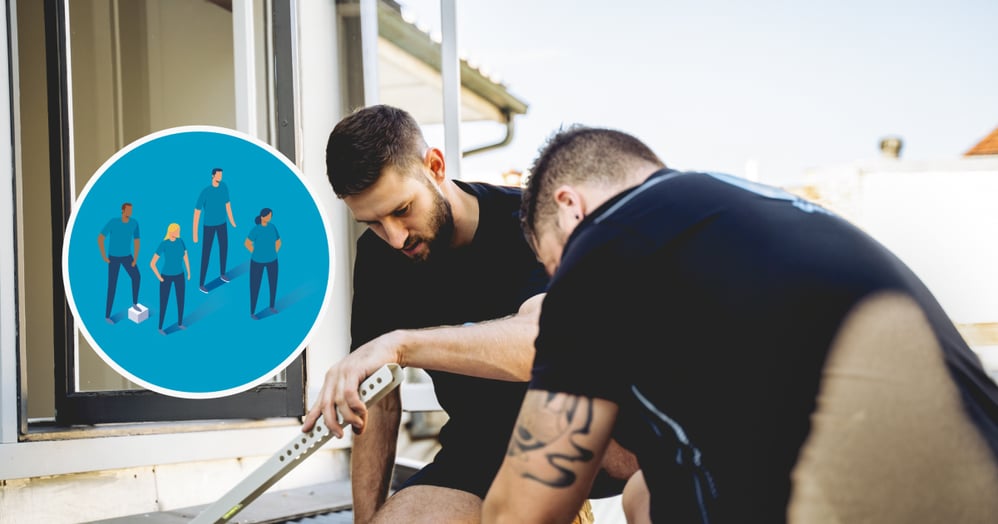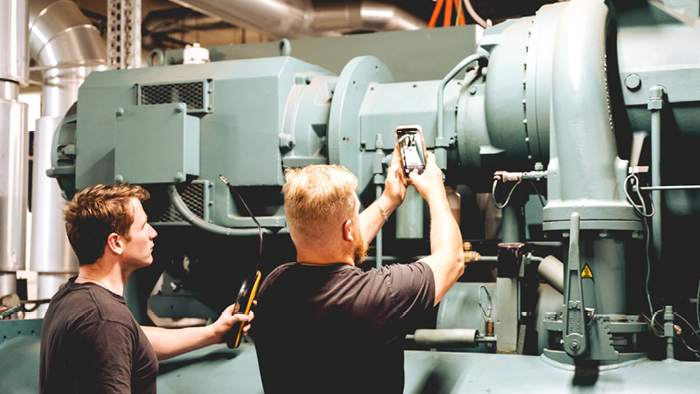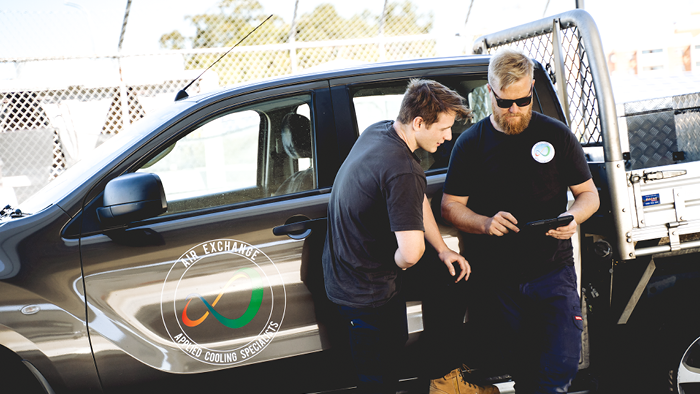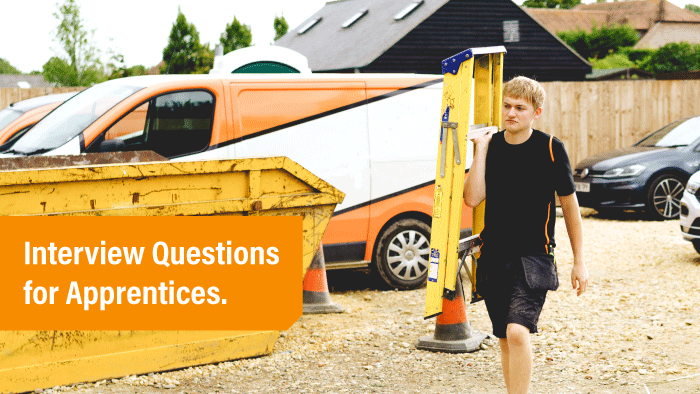How To Train an Apprentice
by Team Tradify, October 25, 2023

Table of Contents
Fresh out of school, many young people rush to university to get a degree. While that route suits some people, many find themselves left with a hefty student loan and no clue what to do with their new qualifications. More and more people are realising that a trade apprenticeship is a smart move. Not only can you earn while you learn, but you also have a clear career path, with endless progression opportunities once you’re qualified.
Get your new apprentice ready for action with our free Employee Handbook Template!
As thousands of fresh faces start apprenticeships each year, it’s a great opportunity to expand your trade business and hire someone new. Depending on where you live, there may even be government incentives for employers to train an apprentice.
If it’s been a while since you were an apprentice yourself, you might want to update your knowledge. Here’s what you need to know about training an apprentice.
Short on time? Jump ahead:
- 1.Find the right fit
- 2.Apprentice onboarding
- 3.Your obligations
- 4.How long does it take to get qualified?
- 5.Hire an apprentice, grow your business
1. Find the right fit
Hiring an apprentice is like adding another player to your sports team. You need to make sure they fit in terms of work ethic and personality traits – things like being hard-working and reliable go a long way.
Hiring an apprentice is a big undertaking and you need to make sure you’re mentally up to the task, but it’s a small investment for long-term gains. Having an apprentice on board with youthful energy and a hard-working attitude will benefit your business three-fold:
- You can train them from scratch, teaching them the way you expect them to work.
- They can assist with entry-level tasks, freeing up seniors to perform more profitable tasks.
- You help grow your industry by producing a high-qualified professional.
If you’re on the hunt for the perfect person, our guide on how to hire an apprentice will help. If you’ve already got someone lined up for an interview, make sure to run through our list of interview questions for apprentices so you know they’re up to the task.

Understanding differences
When hiring an apprentice, it’s important to remember that everyone learns differently. Before starting, have a chat with your apprentice about how they learn best. The purpose of an apprenticeship is to learn on the job, but some people learn best by observing and others are more hands-on. Knowing what makes your apprentice tick is your best chance at making sure their training is well-supported.
2. Apprentice onboarding
Having an onboarding strategy will make all the difference in the long-term success of your apprentice. Otherwise, you’ll likely leave them feeling confused, out of place, unmotivated or not knowing how to do their job properly – making the worksite less productive. Here’s what makes a smooth onboarding process:
-
Make them feel welcome
Even before their first day, make apprentices feel welcome. Things as simple as sending them updates about the business or showing them how to use Tradify are easy ways to make them feel welcome and increase productivity and motivation.
-
Set expectations
Make sure you start on the same page – it’s the easiest way to prevent any miscommunication. Outline your expectations of work hours, job commitment and any other site matters, and allow apprentices to voice any of their own expectations.
-
Outline work goals
Keep in mind that your apprentice is new to the field and might feel a bit out of depth in the first few weeks. For an easier transition, encourage them to set some goals and ask how you can support them to achieve those goals.
-
Encourage feedback
It doesn’t matter how long staff have been with you, feedback should always be a priority. If they feel like they have a voice, they’ll feel a sense of value and belonging – which will increase motivation and productivity.
-
Check-in regularly
Arrange a weekly check-in with your apprentice, particularly in the first few months, to keep in the loop with how they’re going. Things will run a lot more smoothly if you sort things as they happen – rather than leaving them to pile up. Plus, it’ll make your business more profitable and productive if you keep an eye on their progress and offer advice when it’s needed.
3. Your obligations
Taking on an apprentice is a big commitment – you need to be aware of your responsibilities, to avoid any hiccups.
-
Oversee the theory
Alongside working on the job, your apprentice must be officially enrolled in an apprenticeship programme – whether you’re in the UK, Australia or New Zealand.
-
Make their work a priority
To get qualified, an apprentice needs to complete a range of paperwork to support their practical on-site learning. It’s your job to assess this and sign the paperwork off when they’ve achieved it.
-
Educate and inform
As the boss, you’ll need to teach apprentices everything they need to know to become qualified in your trade. When they complete their apprenticeship, they should be fully equipped as professionals in the field. You’ll be responsible for ensuring they get there.
-
Ensure a safe working environment
As soon as they start, you need to bring your apprentices up to speed with workplace health and safety policies, so they know how to keep themselves safe at work. See our guides on health and safety requirements in the workplace to make sure you’re on track – UK, Australia or New Zealand.
-
Pay a fair wage
There are guidelines you must follow to ensure you pay your apprentice fairly and correctly.
UK – Apprentices must be paid at least the minimum wage.
AU – You must pay your apprentice according to trainee pay rates.
NZ – Apprentices are entitled to at least the minimum wage.
-
Monitor workload
It’s important to look after your apprentices and remember they’re new to the job. Think carefully about overtime. There’s almost always a written component to completing an apprenticeship that they need adequate time to complete.

4. How long does it take to get qualified?
Electrician
UK - An electrical apprenticeship in the UK is typically completed over four years.
Australia - In Australia, apprentices need to get a Certificate II in Electrotechnology which takes four years.
New Zealand - An apprenticeship in New Zealand takes between three and four years.
Plumber
UK - An intermediate or advanced plumbing apprenticeship will take up to four years in the UK.
Australia - Plumbing apprenticeships take four years to complete in Australia.
New Zealand - Plumbing apprenticeships take two to four years in New Zealand.
HVAC
UK - Depending on the level, an air conditioning and refrigeration apprenticeship takes one to five years in the UK.
Australia - On average, it will take four years in Australia.
New Zealand - One to four years in New Zealand.
Construction
UK - Depending on the level, construction apprenticeships can take between one and five years in the UK.
Australia - It takes around four years to become fully qualified in Australia.
New Zealand - Construction apprenticeships take between three and four years in New Zealand.

5. Hire an apprentice, grow your business
There’s no better way to grow your business than to get an apprentice on board. Not only is it good for the future of trade industries to pass on skills and knowledge, but an apprentice will also add new ideas and vibrancy to your business. The key is knowing how to train someone correctly, ensuring they get the best start so they feel empowered and your business thrives.
Download your free Interview Questions for Apprentices!
Get your paperwork sorted so jobs run smoothly when your apprentice starts. Sign up for a free 14-day Tradify trial, or jump into one of our weekly live walkthroughs.
Related articles

Quick Quotes Mean More Jobs for Sharp Air Conditioning

How To Set Up a Google Business Profile (for Trade Businesses)

Aussie Electrician Reduces Admin Time by 95%
Give Tradify a go for free!
Save 10+ hours/week on business admin with the highest-rated job management software for tradespeople.
With free one-on-one training and phone support, it's never been easier to get started.



